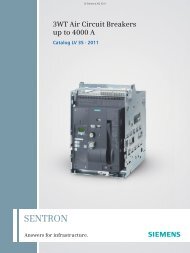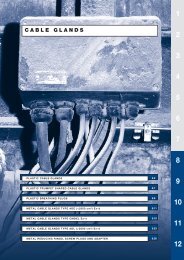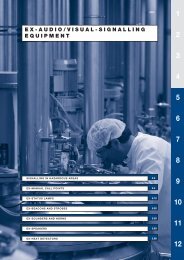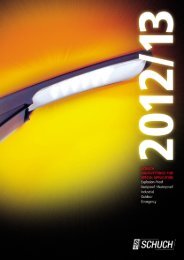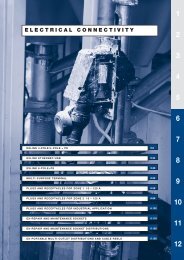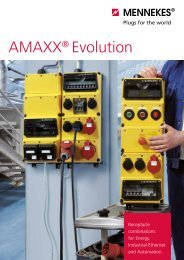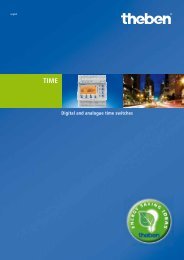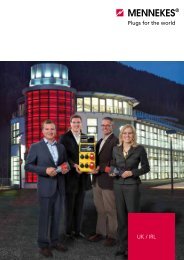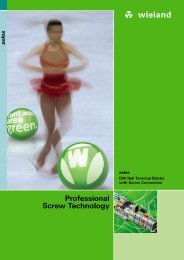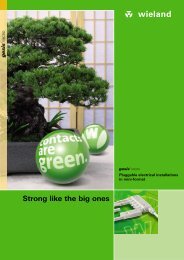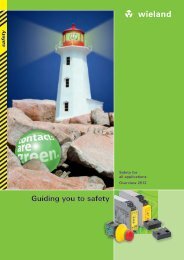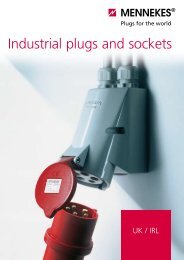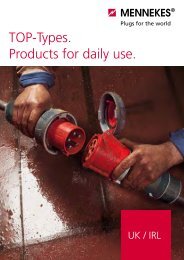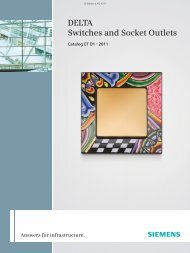You also want an ePaper? Increase the reach of your titles
YUMPU automatically turns print PDFs into web optimized ePapers that Google loves.
1<br />
2<br />
Focussing Stab<strong>ex</strong> HF Focussing HE 8<br />
3<br />
Lighting technology<br />
as a pioneer for innovative light<br />
the constant voltage, the high energy<br />
Depending on their use, <strong>ex</strong>plosion -<br />
protected <strong>portable</strong> <strong>lamps</strong> are required<br />
to have different luminous intensity<br />
distributions, such as a broad beam<br />
(working light) or a spotlight. This is<br />
achieved by the use of powerful <strong>lamps</strong><br />
and different systems of focussing the<br />
light. In the new types of CEAG lights<br />
the need to be able to focus the<br />
light has been realized by the use<br />
of an adjustable reflector. This kind<br />
of reflector enables focussing a broad<br />
beam into a spotlight. Different slip-on<br />
filte<strong>rs</strong> enable a change of light colour.<br />
A novel dispe<strong>rs</strong>ive filter composed<br />
of many small prisms enables the<br />
beam of light to be broadened without<br />
a major loss of working light.<br />
Halogen <strong>lamps</strong> with a<br />
double bulb: bright and cool<br />
Halogen <strong>lamps</strong> have a very bright,<br />
systems starts with the introduction<br />
of the new Stab<strong>ex</strong> mini II this LED<br />
technique combined with optimized<br />
reflector technique. The robust lamp<br />
enclosure combined with the longlasting<br />
and vibration-insensitive LED<br />
source will increase additional safety<br />
for the operator.<br />
Guidance of light<br />
In order to achieve optimum lighting<br />
properties, all components are analyzed,<br />
calculated and measured. The<br />
development and manufacture of the<br />
series are based on the results of our<br />
in-house light laboratory. The range<br />
diagrams essential for a <strong>portable</strong> lamp,<br />
have been derived from the polar curves<br />
established by the light laboratory.<br />
These diagrams tell the user at what<br />
distance a round surface is irradiated<br />
with an illumination of min. 1 lux.<br />
density and the suitability for use in<br />
hazardous areas. Discharged NiCd<br />
batteries can easily be stored for<br />
several yea<strong>rs</strong>. NiCd batteries have<br />
to be recylcled and are almost 100 %<br />
reusable.<br />
Furthermore new battery concepts<br />
are implemented to increase<br />
the light duration of the lamp. The<br />
hand-lamp series SEB 9 for <strong>ex</strong>ample<br />
is equipped with new nickel-metal<br />
hydride (NiMH) batteries. The<br />
operating time of the main lamp<br />
will be increased to 7 h. (5.5 with<br />
NiCd)<br />
Hand <strong>lamps</strong> type „CEAG“ may be used<br />
only with certified battery packs.<br />
4<br />
5<br />
6<br />
7<br />
white light, but due to their high surface<br />
temperature their light output must be<br />
limited. By means of a special method,<br />
whereby the halogen lamp is provided<br />
with a “double bulb”, Cooper Crouse-<br />
Hinds GmbH has considerably<br />
increased the useful light output. Thus,<br />
<strong>ex</strong>plosion-protected lights can make<br />
optimum use of the advantages of<br />
the halogen lamp (high light output,<br />
pleasant light colour and long service<br />
life).<br />
LEDs: robust and long-lasting<br />
With substantial progress of LED technique<br />
in the last yea<strong>rs</strong> today <strong>ex</strong>ists new<br />
product-specific designed light sources<br />
for hand<strong>lamps</strong>. Cooper Crouse Hinds<br />
Battery Technology<br />
The CEAG <strong>ex</strong>plosion-protected<br />
<strong>lamps</strong> can be fitted with rechargeable<br />
(secondary cells) or non-rechargeable<br />
batteries (primary cells). Which battery<br />
is best from an economical point<br />
of view depends on the respective<br />
application. If <strong>lamps</strong> are used on an<br />
irregular basis, high-quality primary<br />
cells (alkaline manganese batteries)<br />
to IEC 60086 should be used. If the<br />
<strong>lamps</strong> are used frequently, it is pre -<br />
ferable to use gas-tight, rechargeable<br />
nickel cadmium batteries (NiCd). In<br />
addition to the fact that they are<br />
<strong>ex</strong>tremely economical, the outstanding<br />
characteristics of these batteries are<br />
Rechargeable battery for SEB 8<br />
8<br />
9<br />
10<br />
11<br />
12<br />
COOPER CROUSE-HINDS GMBH 1.3



